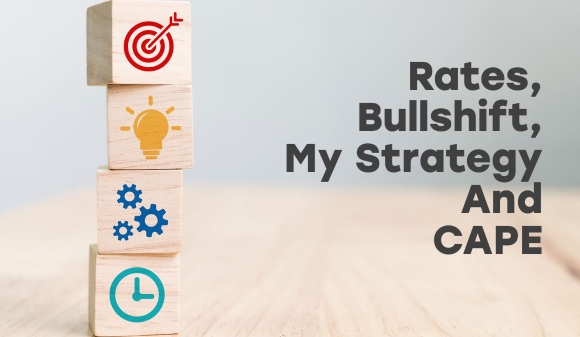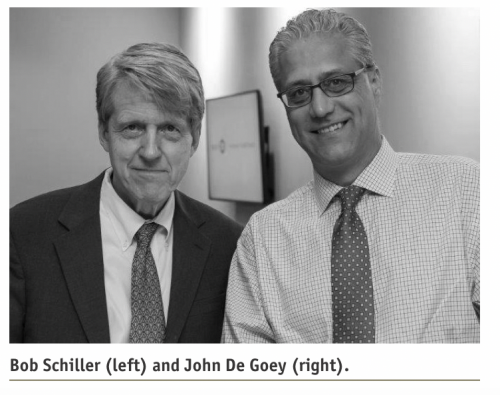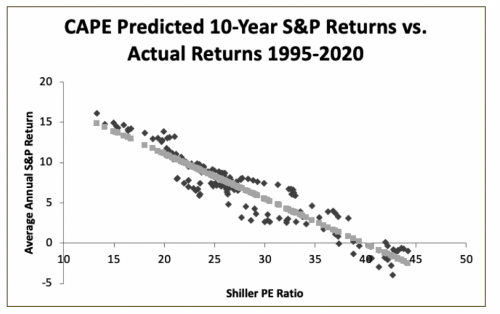Rates, Bullshift, My Strategy And CAPE

 As most readers will likely know, there’s an inverse correlation between interest rates and Price/Earnings (P/E) ratios. This is especially true for the Shiller Cyclically Adjusted Price Earnings (CAPE) ratio. This relationship is both intellectually intuitive and empirically obvious once you superimpose and examine the data. The simple reason revolves around the interplay between risk and return. When the risk-free rate is extremely high, as it was in the early 1980s, people will simply avoid taking much of it because the guaranteed return on bonds is so attractive. This is especially true for so-called “ordinary investors”, where most of the money is held in government sponsored plans like Registered Retirement Savings Plans (RRSPs) or, more recently, Tax-Free Savings Plans (TFSAs), since the higher inclusion rate on income is not a factor in registered plans.
As most readers will likely know, there’s an inverse correlation between interest rates and Price/Earnings (P/E) ratios. This is especially true for the Shiller Cyclically Adjusted Price Earnings (CAPE) ratio. This relationship is both intellectually intuitive and empirically obvious once you superimpose and examine the data. The simple reason revolves around the interplay between risk and return. When the risk-free rate is extremely high, as it was in the early 1980s, people will simply avoid taking much of it because the guaranteed return on bonds is so attractive. This is especially true for so-called “ordinary investors”, where most of the money is held in government sponsored plans like Registered Retirement Savings Plans (RRSPs) or, more recently, Tax-Free Savings Plans (TFSAs), since the higher inclusion rate on income is not a factor in registered plans.
In the current environment, the situation is reversed. Interest rates are piddling, so investors are prepared to take on more risk. There is no meaningful alternative. Having a guarantee is nice, but when that guarantee is essentially nothing more than a simple assurance of getting your own money back, most people would sooner take their chances elsewhere. That grudging willingness to invest in something—anything—that at least has a chance of making money down the road can cause people to take risks that they would never take in “ordinary” times.
Many advisors act as though this risk/reward tradeoff is immaterial. It most certainly is not. They speak glowingly of their role as behavioural coaches since they usually dissuade their clients from making knee-jerk decisions about anything that has so much as a hint of market timing associated with it. To be clear, I’m not opposed to focus and discipline—far from it. However, I am opposed to parking your brain at the door and ignoring extreme developments simply because things generally go a certain way under “normal” circumstances. At the very least, advisors should acknowledge the high probability of disappointment a stock investor might encounter under these conditions. The risk to investors is enormous, but advisors are collectively whistling past the graveyard with blithe indifference to the times they live in. They usually don’t even mention any concern about high valuations. This is a “bubble” environment.
Bullshift
I’m working on a new book to be released in 2021 called “Bullshift”. It’s cheeky, I know. The word is a portmanteau with two constituent parts: bull (as in the belief that markets will rise) and shift (as in the diversion of attention). The financial services industry, in my respectful and considered opinion, has an “all optimism, all the time” mindset that does not always serve investors well, especially when markets are expensive.
As a result of the mindset noted above, I call Bullshift. No one giving advice to retail clients seems willing to contemplate the demise of their own business model and value proposition. So, advisors deny it, as if it will go away as a result of being ignored. This is clear evidence of both status quo basis and self-serving bias. It’s like the cigarette industry in the 1960s or big oil in the 2010s. Instead of solving the problem, the participants deny, deflect and discredit those who are pointing out self-evident truths.
Since there is no credible way to rebuff observable behaviour, most advisors simply don’t talk about it and hope no one will notice. I would not go so far as to call this malfeasance, but I would go so far as to suggest a severe overabundance of optimism owing to the lack of critical thinking and contextualization that advisors so often promote as part of why their involvement in decision-making is necessary. It’s simply not reasonable to portray the stock market glass as being at least half full all the time, no matter what.
In 2020, Donald Trump told bald-faced lies about voter fraud and claimed—without a shred of evidence—that there were massive, material irregularities in the American electoral process. He did so before, during and after the election. Unfortunately, many people have difficulty in discerning truth when they hear a narrative repeated over and over. Indeed, polls in the weeks following the election showed that well over half of the people who voted for him (and a significant portion of those who did not) believed his story. Of course, saying something is true doesn’t make it true. Motivated reasoning is everywhere. Donald Trump provides clear evidence that people at the top are not beyond creating false narratives for personal gain.
We’ve all heard the phrase, “If it ain’t broke, don’t fix it”. So, what if an entire industry profits from the brokenness? Fixing problems that maximize profits is bad for business. Better to deny the problem exists in the first place. Corollary: even if it is broke, if you’re making money as a result of “it” being broken, don’t fix it then, either. Keep it broken (read: profitable) for as long as you can: it’s good for business. Expect narrative fallacies about staying invested through all cycles and conditions to run rampant in the coming years. Surely, there must be some instances where purposeful, strategic (as opposed to random, emotional) selling is warranted. What are those conditions? Like Whitney Houston once said: “How will I know?”
Ignoring dividends and taxes, the 40-year return for bonds is comparable to the 40-year return in stocks for Canada (1980-2020). That’s simply incredible—especially since the P/E ratio for the Canadian stock market was near all-time lows 40 years ago. Simply put, we’ve had a 40-year bull market in both stocks and bonds, but especially in bonds. That is nearing the end. In fact, we may have already reached it. Don’t shoot the messenger, but I fear the good times are largely behind us.
An Update On My Strategy At The Halfway Pole
Around this time last year, I wrote about how I had taken steps in late 2019 to be able to implement an uncommon strategy in 2020. This approach involved re-positioning just over one third of my clients’ overall equity allocation into custom-built inverse notes—products that would rise if markets dropped. These notes were struck in January 2020 with a two-year term, meaning they would mature in January 2022. They are totally liquid in the interim. The Canadian note offered a 40% inverse participation on the TSX and the American note offered a 50% inverse participation on the S&P 500. Both notes were capped at 10% barrier, meaning the most an investor could lose was 10%, even if markets rose by more than that.
As you might imagine, my clients were delighted in late March 2020 when both the Canadian and American stock markets were down by about one-third. Since the notes were only two months out when the markets started to drop, the time left on the options used to underwrite the products meant that there was not a dollar-for-dollar recapture of the move. Markets were down by about one-third, yet my clients were only (!) up by a little under 10% on that portion of their portfolios.
Markets began to rise sharply in late-March 2020 and, by the end of 2020, the Canadian note was only up modestly and the American note was in negative territory. Over the span of about nine months, my reputation with clients, I had transitioned from G.O.A.T. (Greatest Of All Time) to goat (as in the person who shoulders blame when things don’t work out). In fact, I was not, and had never been either. In 2020, the Canadian market was down slightly, and the American market was up slightly (albeit slightly more than Canada was down), but my clients were more or less breaking even. My fellow advisors’ clients were in the black, but in most cases, only modestly so.
Basically, from an overall performance perspective, 2020 was flat. Notably, in addition to my clients’ accounts being essentially flat for the year, they also experienced far less volatility than most in that timeframe. In short, overall performance was a bit less than my peers, but volatility was low. The question of strategic efficacy would now revolve around the year or so leading to January 2022. We’ll see.
As of this writing, bonds are at all-time lows, while (not coincidentally, but rather consequently) stock valuations are near all-time highs. As of the beginning of December 2020, the yield on the 30-year government of Canada bond was 1.2%, while the U.S. Treasury yielded just over 1.5%. An enlightened behavioural investor is likely willing to accept low returns during an economic expansion. However, when the worm turns and markets begin to drop, that same investor is likely to become risk averse. The point is simple: to a large extent, medium-term expected market returns are predictable and dependent on valuations.
The CAPE for the TSX is still in the high 20s, but markets (and particularly the American market) have been expensive for years. In fact, the CAPE for the S&P 500 has been hovering around 30 for half a decade. At the time of publication, it was around 35, which is higher than its historical average has been about 96% of the time. The American stock market is extremely expensive and at the time of writing, COVID-19 cases are reaching all-time highs.
At this point, I need to stress that putting a hedge on North American stocks was intended as a risk management strategy, not as a market call in the traditional sense. Market valuations can remain elevated for many years. Stated differently, my intent was not so much to benefit from a market drop, but rather to protect clients from a drop. This was owing to my concern about valuations and my understanding of history. The notes had two years to maturity because valuations had already been high for some time, but meaningful timing is hard. I wanted the product to reflect a reasonable timeframe to allow the latest financial bubble to pop.
What CAPE Can And Cannot Do
The man behind CAPE, Professor Robert Shiller, is one of my heroes.

He is one of the most celebrated economists of his generation—largely as a result of his work in examining the human behavioural aspects of market movements. For better or worse, he believes markets can experience bubbles. There are two important things to understand about what we mean and understand about such bubbles: they are nearly impossible to time with any degree of accuracy and there is a strong (negative) correlation between a high CAPE reading and the average annualized return of the market over the following decade. In simple terms:
High CAPE = low returns over the following decade
Low CAPE = high returns over the next decade

When I implemented this strategy, I was convinced that the 2020s were shaping up to be a lost decade of sorts. I still fear that. More concretely, it would not surprise me if markets at the end of 2030 will be at levels more or less comparable to where they are today. Still, there is absolutely no way to reliably anticipate when or why a major drop might occur, if it occurs. All anyone can do is to put hedges in place to play defence when you have probable cause to believe there are difficult times around the corner. I stand by (and STANDUP for) my strategy.
John J. De Goey, CIM, CFP, FELLOW OF FPSC™ is a registrant with Wellington-Altus Private Wealth Inc. (WAPW). WAPW is a member of the Canadian Investor Protection Fund (CIPF) and the Investment Industry Regulatory Organization of Canada (IIROC). The opinions expressed herein are those of the author alone and do not necessarily reflect those of WAPW, CIPF or IIROC. His advisory website is: www.standupadvisors.ca.

